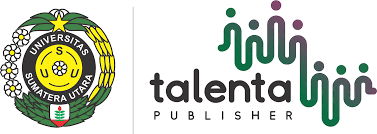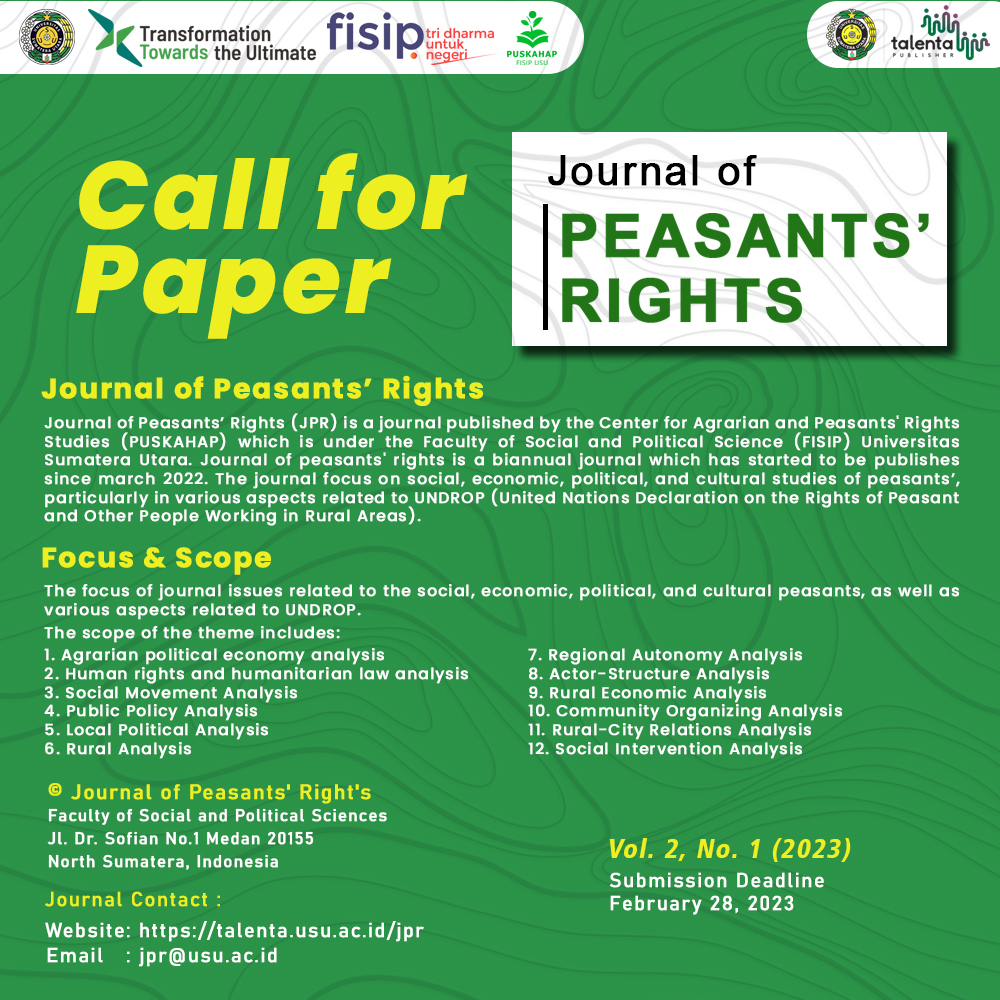Gluten Rice Cultivation and Business in Malaysia: A Social Entrepreneurship Approach in Agent-Structure Analysis
DOI:
https://doi.org/10.32734/jpr.v3i2.19080Keywords:
Agent-structure, gluten rice, gluten business, social entrepreneurshipAbstract
The cultivation of gluten rice in Malaysia is growing with global market demand, creating social entrepreneurship opportunities that empower farmers and offer sustainable social, economic and environmental impacts. The main objective of this study is to analyze gluten rice cultivation and business in Malaysia through a social entrepreneurship approach using agent-structure analysis, where the interactions between key agents such as farmers, social entrepreneurs, government, and consumers, as well as the social, economic, and policy structures that influence them, are analyzed to understand their role in shaping a sustainable and competitive gluten rice industry. The research method used is a literature review with a methodological approach involving identification, analysis and synthesis of literature. Data collection techniques were conducted by utilizing various sources such as books, academic journals, research reports, and articles related to social entrepreneurship, actors in networks, and social value production. The data analysis technique used was descriptive qualitative. Based on the research on gluten rice cultivation in Malaysia with a social entrepreneurship approach through agent-structure analysis, the main conclusions include several important points. First, the roles of key agents such as farmers, social entrepreneurs and consumers shape the supply chain that supports business sustainability. Second, social, economic and policy structures, including green regulations and market access, influence industry. Third, the gluten-free rice business provides economic and social benefits, improving farmers' incomes and supporting healthy lifestyles. Finally, sustainable agricultural practices support environmental sustainability and carbon footprint reduction.
Downloads
References
Abdildinova, N. E. (2024). Social entrepreneurship as alternative form of employment in rural areas. Problems of AgriMarket, 2, 248–257. https://doi.org/10.46666/2024-2.2708-9991.21
Adnan, M., Uddin, M. M., Sulaiman, S., Nor, & bin, A. (2024). The Role of Universiti Malaysia Perlis (UniMAP) In the Socioeconomic Development of Perlis State Through a Social Entrepreneurship Approach. International Journal of Religion, 5(9), 1124–1136. https://doi.org/10.61707/smw8z329
Adnan, N., Nordin, S. M., & Rasli, A. M. (2019). A possible resolution of Malaysian sunset industry by green fertilizer technology: factors affecting the adoption among paddy farmers. Environmental Science and Pollution Research, 26, 27198–27224. https://doi.org/10.1007/s11356-019-05650-9
Ali, M. M., & Hashim, N. (2024). Exploring Nutritional Composition, Volatile Compounds, Health Benefits, Emerging Processing Technologies, and Potential Food Products of Glutinous Rice: A Review. Rice Science/Rice Science. https://doi.org/10.1016/j.rsci.2024.02.002
Anastasiadou, E. (2023). Exploring Business Actor Engagement Dynamics: An Abstract. Developments in Marketing Science: Proceedings of the Academy of Marketing Science (DMSPAMS) , 243–244. https://doi.org/10.1007/978-3-031-24687-6_98
Anwar, Y., Jatsiyah, V., Zahari, N. M., Saefudin, A., & Nofirman, N. (2023). Transforming Traditional Farmers into Professionals: An Introduction to Human Resource Management in Rural. Jurnal Penelitian Pendidikan IPA, 9(12), 12266–12275. https://doi.org/10.29303/jppipa.v9i12.6543
Azis, M., Wahida, W., Sumedi, S., Yofa, R. D., Iffah, S. I., Sahabat, I., Purwanto, P., & Setiawan, F. (2024). Market performance of rice in Banten Province: A structure-conduct-performance approach. BIO Web of Conferences, 119, 02012–02012. https://doi.org/10.1051/bioconf/202411902012
Binth, T. S. (2024). Global Importance of Rice Cultivation in Maintaining Ecological Balance: A Focus on Kerala, India. Journal of Experimental Agriculture International, 46(8), 723–739. https://doi.org/10.9734/jeai/2024/v46i82755
Brorsen, B. W., Chavas, J.-P., & Grant, W. R. (1991). Market Structure and Spatial Price Dynamics. Journal of Agricultural and Applied Economics, 23(2), 65–74. https://doi.org/10.1017/s0081305200018185
Celiac.org. (2020, February 20). Incidence of Celiac Disease Steadily Increasing | Celiac Disease Foundation. Celiac Disease Foundation; Celiac.org. https://celiac.org/2020/02/20/incidence-of-celiac-disease-steadily-increasing/
Dindo Campilan. (2011). Enhancing farmers’ capacity to link with markets. RePEc: Research Papers in Economics. https://doi.org/10.22004/ag.econ.125314
Dorairaj, D., & Govender, N. T. (2023). Rice and paddy industry in Malaysia: governance and policies, research trends, technology adoption and resilience. Rice and Paddy Industry in Malaysia: Governance and Policies, Research Trends, Technology Adoption and Resilience, 7. https://doi.org/10.3389/fsufs.2023.1093605
Emodi, A., & Madukwe, M. (2011). Linkage Mechanisms among key Actors in Rice Innovation System in Southeast Nigeria. Journal of Agricultural Extension, 14(2). https://doi.org/10.4314/jae.v14i2.64124
Fatah, F. A. (2017). Competitiveness and Efficiency of Rice Production in Malaysia. International Ph. D. Program for Agricultural Sciences in Goettingen (IPAG). https://doi.org/10.53846/goediss-6160
Feenstra, G., & Lewis, C. (1999). Farmers’ markets offer new business opportunities for farmers. California Agriculture, 53(6), 25–29. https://doi.org/10.3733/ca.v053n06p25
Giddens, A. (1984). The constitution of society: Introduction of the theory of structuration. University Of California Press.
Godwin, C. N., & Crocker-Billingsley, J. (2024). Social Entrepreneurship. Encyclopedia of Social Work. https://doi.org/10.1093/acrefore/9780199975839.013.1304
Haque, M. A., Rafii, M. Y., Yusoff, M. M., Ali, N. S., Yusuff, O., Datta, D. R., Anisuzzaman, M., & Ikbal, M. F. (2021). Recent Advances in Rice Varietal Development for Durable Resistance to Biotic and Abiotic Stresses through Marker-Assisted Gene Pyramiding. Sustainability, 13(19), 10806. https://doi.org/10.3390/su131910806
Herlina, H. (2022). Farm Shop Marketing Strategy Forward Together In Increasing Farmers Purchasing Power. Baselang, 2(2), 118–126. https://doi.org/10.36355/bsl.v2i2.74
Issahaku, A., Obeng, F., Akudugu, A., & Yeboah, R. (2022). Training of Rice Farmers and Its Effect on Socio-Economic Assets Acquisition and Change in Status. Business Management and Strategy, 13(2), 1–1. https://doi.org/10.5296/bms.v13i2.19973
Khairuddin, M. A. N., & Lasekan, O. (2021). Gluten-Free Cereal Products and Beverages: A Review of Their Health Benefits in the Last Five Years. Foods, 10(11), 2523. https://doi.org/10.3390/foods10112523
Kim, H., Sefcik, J. S., & Bradway, C. (2017). Characteristics of qualitative descriptive studies: A systematic review. Research in Nursing & Health, 40(1), 23–42. https://doi.org/10.1002/nur.21768
Kishioka, T., Hashimoto, S., Nishi, M., Saito, O., & Kohsaka, R. (2017). Fostering cooperation between farmers and public and private actors to expand environmentally friendly rice cultivation: intermediary functions and farmers’ perspectives. International Journal of Agricultural Sustainability, 15(5), 593–612. https://doi.org/10.1080/14735903.2017.1374321
Kohonen, M. (2012). Actor-network theory as an approach to social enterprise and social value: a case study of Ghanaian social enterprises - LSE Theses Online. Lse.ac.uk. http://etheses.lse.ac.uk/650/1/Kohonen_Actor-network_theory.pdf
Nur, N., Jamaluddin, A., & Badari, S. A. Z. (2023). The Understanding of Household Food Security among Glutinous Rice Smallholder Farmer in Langkawi, Malaysia. International Journal of Academic Research in Business and Social Sciences, 13(16). https://doi.org/10.6007/ijarbss/v13-i16/18761
Onumah, G., & Proctor, U. (2007). Munich Personal RePEc Archive Empowering Smallholder Farmers in Markets: Changing agricultural marketing systems and innovative responses by producer organizations. https://mpra.ub.uni-muenchen.de/25984/1/MPRA_paper_25984.pdf
Pandey, S. C., Modi, P., Pereira, V., & Wamba, S. F. (2024). Empowering small farmers for sustainable agriculture: a human resource approach to SDG-driven training and innovation. International Journal of Manpower. https://doi.org/10.1108/ijm-11-2023-0655
Porter, M., & Kramer, M. (2011). The Big idea Creating Shared Value how to reinvent capitalism-and unleash a wave of innovation and growth (pp. 1–17). https://www.communitylivingbc.ca/wp-content/uploads/2018/05/Creating-Shared-Value.pdf
Pumihic, M. B. (2023). Profitability of Actors in the Value Chain of Commercial Rice. International Journal of Engineering, Business and Management, 7(3), 58–66. https://doi.org/10.22161/ijebm.7.3.10
Rezza, M., & Simatupang, E. (2023). Community Empowerment Through Organic Rice Cultivation: Creating a Sustainable Agricultural Environment. PRIMA PORTAL RISET DAN INOVASI PENGABDIAN MASYARAKAT, 2(3), 326–331. https://doi.org/10.55047/prima.v2i3.839
Sattaka, P., Muengpak, S., Phan, H., & Mueangkhot, T. (2020). COMPARISON OF GLUTINOUS RICE PRODUCTION SYSTEMS FOR SUSTAINABLE DEVELOPMENT IN SAKON NAKHON PROVINCE. J. ISSAAS, 26(1), 54–62. http://issaasphil.org/wp-content/uploads/2020/06/5.-Sattaka-etal-2020-Comparison-of-Glutinous-rice-Production-System-FINAL.pdf
Sattaka, P. (2016). Geographical Distribution of Glutinous Rice in the Greater Mekong Sub-region. Journal of Mekong Societies, 12(3), 27–48. https://doi.org/10.14456/jms.2016.23
Sattaka, P., Pattaratuma, S., & Attawipakpaisan, G. (2017). Agricultural extension services to foster production sustainability for food and cultural security of glutinous rice farmers in Vietnam. Kasetsart Journal of Social Sciences, 38(1), 74–80. https://doi.org/10.1016/j.kjss.2016.05.003
Schwab, K. (2017). The Fourth Industrial Revolution. Crown Business.
Sendilkumar, R. (2012). Empowerment of Farmers through GALASA Programme- A Journey for Sustainable Agriculture Development. Indian Res. J. Ext. Edu, 12(3). https://api.seea.org.in/uploads/pdf/v12317.pdf
Sneed, C., & Fairhurst, A. (2010). From the Boardroom to the Farm Stand: Applying Principles of Retail Strategy to Facilitate Farmers’ Market Sustainability. Journal of Agriculture, Food Systems, and Community Development, 1(1), 149–159. https://doi.org/10.5304/jafscd.2010.011.015
Snyder, H. (2019). Literature review as a research methodology: An overview and guidelines. Journal of Business Research, 104(1), 333–339. ScienceDirect. https://doi.org/10.1016/j.jbusres.2019.07.039
Veni, P., & Swetha, M. (2018). Knowledge gain of farmers by Krishi Vigyan Kendra training programmes. ~ 2297 ~ International Journal of Chemical Studies, 6(5), 2297–2299. https://www.chemijournal.com/archives/2018/vol6issue5/PartAN/6-5-411-228.pdf
Waleed Fouad Abobatta, & Fouad, F. W. (2024). Sustainable Agricultural Development. Advances in Environmental Engineering and Green Technologies Book Series, 1–27. https://doi.org/10.4018/979-8-3693-4240-4.ch001
Widyarini, M., & Pawitan, G. (2012). RICE VALUE CHAIN : A STRUCTURATION THEORY APPROACH. https://journal.unpar.ac.id/index.php/Sosial/article/view/147/132
Zaman, N. B. K., Ali, J., & Othman, Z. (2015). PERBANDINGAN CIRI-CIRI SOSIOEKONOMI PENERIMA INOVASI SISTEM INTENSIFIKASI PADI DAN PROJEK ESTET PADI. Jurnal Teknologi, 77(4). https://doi.org/10.11113/jt.v77.6057






